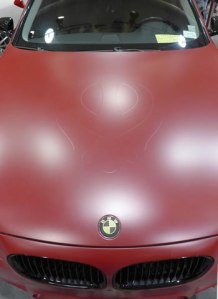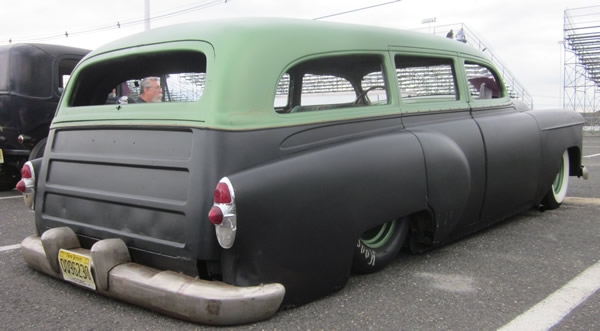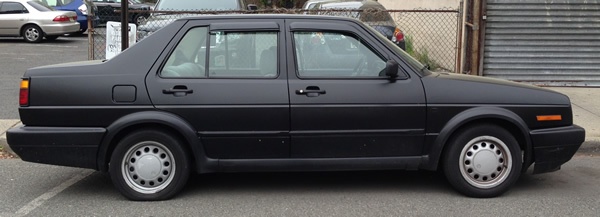Flat paint has long been the look of a car in transition, covering globs of bondo and smoothing out rusty patches. Lately, however, a matte finish is the desired end result and not just a step in the painting process. Many customizers and exotic car owners have been turning away from the traditional high polished finish in favor of matte paint and wraps. The New York International Auto Show I attended last month hosted the Dub Show Tour, a custom car exhibition featuring acres of chrome and gloss. Mixed in with the Louis Vuitton interiors and gold plated wheels, a few cars sported flat paint finishes. The contrast was immediate and lent the cars a strange classiness and subdued elegance. How did we get here?
 Back in high school I had a friend who had the privilege of getting a 1964 Pontiac Bonneville handed down to him from his grandfather. It was a huge car and he nursed it to amazing health over the years. While he would eventually restore the car's paint finish to a cool glossy white, for much of the late 80's it cruised the streets in primer gray. The coat of primer kept the body protected while he worked on the rest of the car, including its "Tripower" three twin-barrel carburetors.
Back in high school I had a friend who had the privilege of getting a 1964 Pontiac Bonneville handed down to him from his grandfather. It was a huge car and he nursed it to amazing health over the years. While he would eventually restore the car's paint finish to a cool glossy white, for much of the late 80's it cruised the streets in primer gray. The coat of primer kept the body protected while he worked on the rest of the car, including its "Tripower" three twin-barrel carburetors.
Military vehicles and aircraft use flat paint to help them blend with their surroundings. Can you imagine a glittering tank with a thick sheen of glossy clear-coat? It wouldn't be around for long, that's for sure. Olive drab isn't much to look at so flat finishes were only seen on military vehicles throughout the 20th century. It wasn't until the late 1980s and the introduction of the B2 stealth bomber, with its radar-absorbing flat black paint, that the American public became captivated by a matte finish.
The 1989 Batman movie, directed by Tim Burton, reimagined the iconic Batmobile in this kind of dull black finish. Unlike the George Barris designed glossy and chrome muscle car of the 1960s television series, the new Batmobile was a grim, turbine powered rocket on wheels cruising the streets of Gotham City in satin black. There was a little bit of a sheen, but not much. The Batmobile of 2005's Batman Begins, however, featuring a fully matte black finish, enhancing its industrial military look and showcasing the car's creases and facets. It was this reimagining of the bat mobile that seemed to trigger the trend in the general public to finish cars in flat black.
One of the major differences in the look of flat paint as opposed to glossy is the amount of reflection. They show off the curves and creases in bodywork in a totally different way. You can see a mirror image of yourself on the hood of a highly polished glossy black car. Clouds and trees will also reflect in the finish. On a matte car, however, all that you see is the body panels themselves. Also, the flat paint reduces the full spectrum of light that appears to the eye and enhances the appearance of color. On a high gloss car, for example, the eye will see highlights as a bright white, no matter what color the car is. On a matte finish, since there isn't a highlight, the eye sees these points as a lighter version of the color on the car. There's a reduced visual spectrum of color from light to dark and the gradient of color looks more subtle.
It's this "purity of color" that I believe is one of the reasons matte finish exploded in the exotic car scene. While I think matte black looks dull and dingy, other colors give vehicles a certain elegance and sophistication, enhancing the curves and creases of expensive body panels. If you're cruising the streets in a Lamborghini Aventador, do you really want the reflection of an old F150 on your door at the stoplight? Probably not.

Another place that has seen a rise in flat paints is the rat rod scene. Here we have cars from the 1930s-1960s purposely painted as if the are transitioning from the custom car shop. Looking like the post-WWII hot rods they are, customizers in the 21st century are even going so far as to replicate the look of rust and aged patina to make these cars look like the just rolled in from a zombie apocalypse. Bondo red and gunmetal gray is fitting for these rockabilly roadsters.

BMW was one of the first manufacturers to offer matte paint as an option for new cars in 2010. The "Frozen" finish was offered first in gray on the limited edition M3 Coupe and has now been expanded to include at least 5 colors, at an additional cost of $5000. On the lower end, Hyundai recently introduced a matte gray version of their Veloster Turbo. Both car makers issue warnings to buyers about how to take care of their paint. Veloster owners get a separate, 11 page manual describing how to treat the paint. No wax, no polish, no buffing, no automatic car washes. Doing any of this things can cause the finish to have an uneven sheen and ruin the look.

While a flat paint finish is permanent and can be quite costly, vinyl wraps and Plastidip spray coating can be a more affordable, temporary way to get the flat finish on your car. Since they're removable they also protect the paint below, allowing owners to go back to their glossy finish if the matte paint fad fades in time.
Flat paint used to be the province of body shops and military vehicles, but over the past few years it has seeped into the custom and commercial markets. The matte finish diffracts light, giving the car a dull look. This look is thrilling to some but it's not for everyone. What do you think?

About the author: Jay Boucher
Jay Boucher is a weekend DIY mechanic who loves station wagons and redblock Volvos. When he's not scraping his knuckles under his 1992 Volvo 245, he's working as a freelance illustrator and interactive designer in northern NJ. Jay's portfolio is at jayboucher.com and he blogs at myblackbrick.com.











